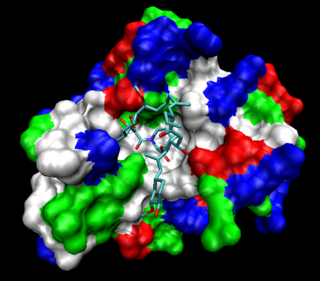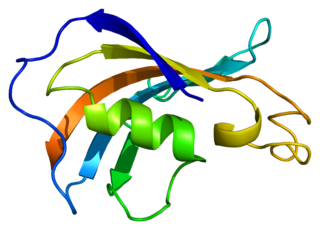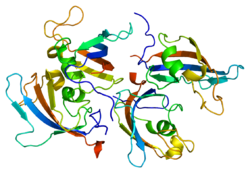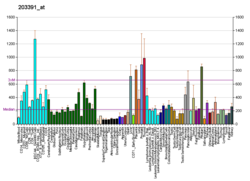
The mammalian target of rapamycin (mTOR), also referred to as the mechanistic target of rapamycin, and sometimes called FK506-binding protein 12-rapamycin-associated protein 1 (FRAP1), is a kinase that in humans is encoded by the MTOR gene. mTOR is a member of the phosphatidylinositol 3-kinase-related kinase family of protein kinases.

The FKBPs, or FK506 binding proteins, constitute a family of proteins that have prolyl isomerase activity and are related to the cyclophilins in function, though not in amino acid sequence. FKBPs have been identified in many eukaryotes, ranging from yeast to humans, and function as protein folding chaperones for proteins containing proline residues. Along with cyclophilin, FKBPs belong to the immunophilin family.

FK506-binding protein 4 is a protein that in humans is encoded by the FKBP4 gene.

Peptidyl-prolyl cis-trans isomerase FKBP1A is an enzyme that in humans is encoded by the FKBP1A gene. It is also commonly referred to as FKBP-12 or FKBP12 and is a member of a family of FK506-binding proteins (FKBPs).

Ryanodine receptor 2 (RYR2) is one of a class of ryanodine receptors and a protein found primarily in cardiac muscle. In humans, it is encoded by the RYR2 gene. In the process of cardiac calcium-induced calcium release, RYR2 is the major mediator for sarcoplasmic release of stored calcium ions.

HLA class II histocompatibility antigen, DM alpha chain is a protein that in humans is encoded by the HLA-DMA gene.

FK506 binding protein 5, also known as FKBP5, is a protein which in humans is encoded by the FKBP5 gene.

FK506-binding protein 8 is a protein that in humans is encoded by the FKBP8 gene.

Calcineurin subunit B type 1 also known as protein phosphatase 2B regulatory subunit 1 is a protein that in humans is encoded by the PPP3R1 gene.

Peptidyl-prolyl cis-trans isomerase FKBP1B is an enzyme that in humans is encoded by the FKBP1B gene.

Band 4.1-like protein 1 is a protein that in humans is encoded by the EPB41L1 gene.

FK506-binding protein 3 also known as FKBP25 is a protein that in humans is encoded by the FKBP3 gene.

Band 4.1-like protein 2 is a protein that in humans is encoded by the EPB41L2 gene.

Brefeldin A-inhibited guanine nucleotide-exchange protein 1 is a protein that in humans is encoded by the ARFGEF1 gene.

Glomulin is a protein that in humans is encoded by the GLMN gene.

HLA class II histocompatibility antigen, DX beta chain is a protein that in humans is encoded by the HLA-DQB2 gene.

FK506-binding protein 10 is a protein that in humans is encoded by the FKBP10 gene.

FK506-binding protein 9 is a protein that in humans is encoded by the FKBP9 gene.

Chemically Induced Dimerization (CID) is a biological mechanism in which two proteins bind only in the presence of a certain small molecule, enzyme or other dimerizing agent. Genetically engineered CID systems are used in biological research to control protein localization, to manipulate signalling pathways and to induce protein activation.

Interferon-induced transmembrane protein 5 is a gene that encodes a membrane protein thought to play a role in bone mineralization.
























